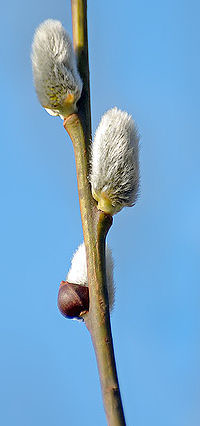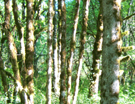Chapter 5: The Best Shrubs
From A Guide to Innovative Tree Farming in the Pacific Northwest by Mike Dubrasich. 2005. Whirlwind Press. For a hard copy of the book ($10 - includes shipping) please contact W.I.S.E. [here].
Best of the Best: Scouler Willow (Salix scouleriana)
Runners-Up: California Hazelnut (Corylus cornuta var. californica), Oceanspray (Holodiscus discolor)
Honorable Mention: Saskatoon Serviceberry (Amelanchier alnifolia), Lewis Mockorange (Philadelphus lewisii)
Tree farmers plant trees, but shrubs often occur on tree farms naturally. The tree farmer’s choices are to ignore the shrubs, poison them, or make profits from them. Innovative tree farmers choose the third option.
The best tree farm shrubs are easy to grow, easy to market, and provide opportunities to add value. Moreover, the best shrubs provide annual income, and hence greater earning power than a periodic crop. One-year-old shoots (rods) are the products tree farmers harvest from shrubs; coppicing is the method employed. Rods are used in basketry, furniture-making, and a variety of arts and crafts.
Scouler Willow
The best shrub for Pacific Northwest tree farmers to grow is Scouler willow. Taxonomists have identified over 50 species, subspecies, and varieties of willow in our region. Scouler willow is the most common, but many other native willows are excellent rod producers. Scouler willows can grow into small trees, but coppicing keeps them short and manageable.
Willows are easy to establish. Winter-cut branch tips or sucker shoots will take root if merely stuck in soil. Willows have an abundance of auxins, the plant hormones used in commercial rooting formulations. In fall, after the willows are well-established, growers cut them off a few inches above ground-level. In the following spring the root crown (coppice stool) will sprout new rods. Growers harvest the rods the in fall, and the cycle repeats.
Growers sell fresh willow rods to florists, or steamed, peeled, and dried rods to craft stores. Craft willow rods are sold by weight; current prices are over $5 per pound. An acre can produce 4 to 5 tons of willows rods every year, and willow farmers can produce annual crops worth over $40,000 per acre in gross sales. Market demand is high, and most of the willow rod supply currently sold in the U.S. is imported from Great Britain. Willow offers enormous profit-making opportunities to innovative tree farmers.
Willows also have catkins that are favored by florists.

California Hazelnut and Oceanspray
Willows are prolific sprouters and will produce dozens of perfect rods from a single mature stool. Our shrub Runners-Up are also prolific sprouters but produce a lower percentage of commercial-grade rods.
Both California hazelnut and oceanspray occur naturally throughout the Pacific Northwest, though both are more common west of the Pacific Crest. Native residents used both species for a variety of crafts; oceanspray rods were especially desired for arrow shafts.
As with willow, California hazelnut and oceanspray are coppiced by innovative tree farmers for commercial production of rods.
The advantage of California hazelnut and oceanspray to tree farmers is that neither needs to be planted; chances are good they are already growing on your tree farm. Coppiced stools of these two species will remain productive for 20 years or more.
Saskatoon Serviceberry and Lewis Mockorange
Two shrub species deserve honorable mention: our native serviceberry and mockorange. Both are common throughout the Pacific Northwest, including east of the Cascades, but neither is as ubiquitous as California hazelnut and oceanspray. Both serviceberry and mockorange can be planted, but not as cheaply and easily as willow. Both species make good rod producers when coppiced. Modern arrow shaft makers prize serviceberry and mockorange rods for their straightness and strength.
Serviceberry and mockorange have two nice features: they produce beautiful flowers and rare wood. The spring flowers of serviceberry and mockorange brighten up tree farms; rare wood is a commercial product. Wood collecting is a popular hobby, much like stamp collecting, rock collecting, or butterfly collecting. Standard wood samples for collecting are 3 x 6 x ½ inches, and include sapwood and heartwood. Samples can be made from stems as small as 8 inches in diameter, a necessity when larger pieces are exceedingly rare. Dozens of wood samples can be made from a single 8-foot long, 8-inch-diameter stem. Standard-sized wood samples of great rarity are sold for $10 or more apiece.
Plants of serviceberry and mockorange are common, but their wood is not. Innovative tree farmers leave uncut a central stem on a coppice stool to grow as large as possible. The stool will continue to produce annual rods, while the central stem increases in diameter every year. Cultured central stems can reach harvest size in 20 years or less.
Rare wood is a worldwide market available to innovative tree farmers, and can be a profitable addition to other crops and products. So are coppiced rods. Shrubs may be vertically-challenged compared to trees, but they can be very profitable tree farm crops.
by Docmoney

Mike, I am new to tree farming/forestry and am considering a purchase of a small tract of land to experiment, learn and hopefully create some revenues.
Having tried to research up Scouler Willow, I was unable to come across information on finding a market for/selling the willow rods. How/where does one come across that information?
Thank you!
Reply: willow rods are similar in shape, strength, and function to Indonesian cane, English willow, hazel, and other craft “sticks”. They are sold wherever sticks are sold, such as craft supply retailers and over the Internet.
Scoulers willow is one of hundreds of willow species, sub-species, and varieties — I mentioned it in the book because it is (one of) the local, native species — all of which can make valuable products.
Marketing innovative products also requires innovative thinking. There may not be “turn key” markets primed and ready. Markets may need to be cultivated.